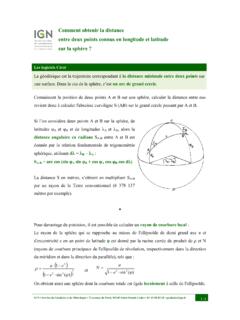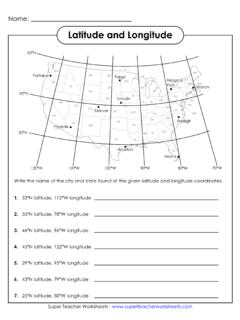Transcription of GRADE 6 GEOGRAPHY TERM 1 LATITUDE AND LONGITUDE …
1 1 GM 2021 GRADE 6 GEOGRAPHY TERM 1 LATITUDE AND LONGITUDE (degrees) Contents Lines of LATITUDE .. 2 Lines of LONGITUDE .. 3 The hemispheres of The Earth .. 4 Finding countries and cities on a map using LATITUDE and LONGITUDE .. 5 Scale .. 5 Small scale and Large scale maps .. 5 Types of map scales .. 8 Measuring straight-line distance between places on a map .. 9 Using line scale to work out straight-line distance .. 9 Kinds of information provided in an atlas .. 10 The Contents Page of an Atlas .. 11 An atlas gives information about provinces .. 12 An atlas gives information about the longest, highest and biggest features of the world 12 Places in the newspapers, on maps .. 13 2 GM 2021 Lines of LATITUDE Lines of LATITUDE : These are imaginary lines, on a map, that show the distance, in degrees, measured from the equator to the poles.
2 The lines of LATITUDE run across the map, horizontally. DID YOU KNOW? Lines of LATITUDE each show ONE degree. The length between two degrees of LATITUDE is 111km. For example, the distance between 21o LATITUDE and 22o LATITUDE is 111km. In GRADE 5 you learnt that the equator is an imaginary line. This line is not found on the earth. This line can only be found on maps. The equator is a line of LATITUDE . It divides the world into two equal parts. The equator line is drawn from west to east (left to right); across the map. If you move north from the equator you will get to the top of the earth. The top of the earth is called the North Pole. If you move south from the equator you will get to the bottom of the earth. This is called the South Pole. A degree of LATITUDE is a measurement of distance over the earth s surface, from north to south.
3 This starts at the equator with zero (0) and ends at the North Pole when you move up towards the South Pole when you move downwards on the map. The symbol for degrees is o. The equator is found at 0o LATITUDE . There are 90o of LATITUDE between the equator and the North Pole. The North Pole is 90oN (Ninety degrees north of the equator). There are 90o of LATITUDE between the equator and the South Pole. 3 GM 2021 The South Pole is 90oS (Ninety degrees south of the equator). There are of LATITUDE between the equator and the Tropic of Cancer. The Tropic of Cancer is (Twenty three and a half degrees north of the equator). There are of LATITUDE between the equator and the Tropic of Capricorn. The Tropic of Capricorn is (Twenty three and a half degrees south of the equator). Lines of LATITUDE Lines of LONGITUDE Lines of LONGITUDE are also imaginary lines but they are drawn from top to bottom across the earth, from north to south on a map.
4 There are two lines of LONGITUDE that have names. One is the Greenwich Meridian which is found at 0o LONGITUDE . It is the equivalent of the equator but from top to bottom instead Lines of LONGITUDE 4 GM 2021 from left to right. At 180o LONGITUDE we find the second named line of LONGITUDE - the International Date Line. Between the Greenwich Meridian and the International Date Line there are 180 degrees of LONGITUDE . The International Date Line is not a straight line. The reason is because it does not pass through any land or country, so it has to miss them. The hemispheres of The Earth The equator divides the earth into two equal halves. The top half is called the Northern Hemisphere1 and the bottom half, the Southern Hemisphere. The Greenwich Meridian also divides the earth into a left and a right side, or rather into a west side and an east side.
5 The Greenwich Meridian divides the earth into a western hemisphere and an eastern hemisphere. So the Equator, at 0o LATITUDE , divides the earth into the northern and southern Hemispheres, while Greenwich Meridian, at 0o LONGITUDE , divides the earth into the western and the eastern hemispheres. NEW WORDS Greenwich Meridian: This is a line of LONGITUDE on a map found at 0o and runs north to south from the North Pole to the South Pole. International Date Line: This is a line of LONGITUDE on a map found at 180o and runs north to south from the North Pole to the South Pole. 1 Hemisphere (say: hem-ee-sfeer) - Hemi means half. Sphere means circle or round shape. Lines of LONGITUDE 5 GM 2021 Finding countries and cities on a map using LATITUDE and LONGITUDE We use lines of LATITUDE and LONGITUDE to find positions or locations on maps.
6 You have learnt to show positions on a map by using a grid of numbers and letters. Can you remember doing something like this? 1 2 3 4 5 A B C D E Scale NEW WORDS Scale: This is the method used to work out the real distance as it would be on the earth from a map Small scale and Large scale maps Drawings of areas of the world are called maps. The scale of a map helps the reader work out the real size and distances between places on earth. Maps can be either small scale or large scale. A numbers and letters grid A political map of the world 6 GM 2021 Because the world, in reality, is so large, if we want to show it on a map we have to make the world smaller. That is why we call maps showing the world small scale maps. Our homes and schools are a much smaller part of the world.
7 That is why we call maps showing the size of our homes or schools large scale maps. Small scale maps show big areas with few small details. Look at the map of the world, below. It is an example of a small scale map. It shows the entire area the world, but a lot of the details are missing. You are able to see the earth, but the map is too small to see any details such as rivers, towns and roads. On the small scale map of Cape Town and its surrounding area, the position of Cape Town can be seen, Robben Island although 11km away from the harbour in Cape Town cannot be seen. The reason why you cannot find Robben Island is because this is a small scale map. Robben Island is too small to be shown on this map. A large scale map shows a small area with more details.
8 On this map of Robben Island we can see lots 7 GM 2021 of details and information. This is called a large scale map even though it is 25 000 times smaller than the real island. The map above, showing the position of Robben Island, is 100 000 times smaller. Street maps are large scale maps. This is because they have to show much more detail of streets for map users to be able to read them accurately. A street map 8 GM 2021 Types of map scales NEW WORDS Line scale: This is a line on the bottom of a map that shows measurements in kilometers. Word scale: Words are used to tell you how to work out distance on the map. There are three types of map scales. This year you will learn to use the line scale and the word scale. Using a line scale on a map is the same as using a ruler to measure distance.
9 The only difference is that line scale measurements are in kilometers (km), while the measurement on a ruler is in centimeters (cm). A line scale shows the measurement in kilometers. To use a line scale, you have to measure the distance using a ruler. You then have to mark off the distance on the line scale. Measure a 5cm distance on the line scale. Begin at the 0km mark. The distance on the line scale is 5km. Well done! You can use a line scale. The word scale tells you about link between the measurement in centimeters on the map and the real or true distance in kilometers on the earth s surface. A word scale is shown in the following way: One centimeter represents 3 kilometers. (1cm = 3 km) Using the word scale above, one centimeter on the map is equal to 3 kilometers on the earth s surface.
10 This is the real distance. You can measure the distance on the map with 9 GM 2021 a ruler and then multiply that number by the 3. This will give you the total distance in kilometers on the earth s surface. 6 cm on map x 3km = 18km Measuring straight-line distance between places on a map A straight-line distance on a map is the distance between two places along a straight line. This distance is measured and then the scale of the map is used to work out the real distance. We hardly ever travel from place to place in a straight line. This is because there are things in the way such as mountains, rivers, farmlands, towns and cities. We use straight-line distances to give us an idea of the distance. In order to measure the straight-line distance between two places, you need to put your ruler on the map, placing it to run from one place to the other places.









